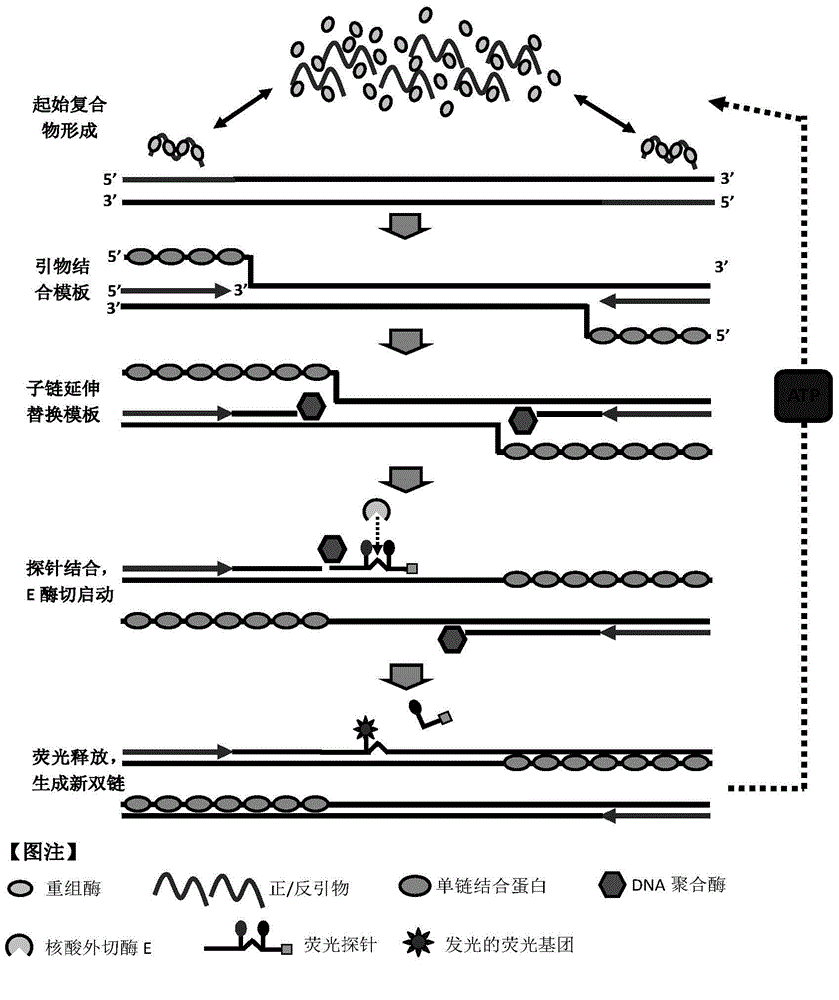Method for rapid fluorescence detection of polynucleotide target objects simultaneously at room temperature and constant temperature
A technology of isothermal and target objects at room temperature, applied in the field of molecular biology, can solve the problems of simultaneous detection, large dependence, and inaccurate PCR product quantification, etc., and achieve the goals of increasing detection accuracy, flexible and simplified selection, and avoiding damage Effect
- Summary
- Abstract
- Description
- Claims
- Application Information
AI Technical Summary
Problems solved by technology
Method used
Image
Examples
Embodiment 1
[0052] This example is used to illustrate the dual fluorescence reaction at room temperature and constant temperature performed on the Twista instrument.
[0053] 1. According to NCBI GenBank and related literature reports, a 523bp sequence (SEQ ID No.6) was selected from the insertion sequence IS6110 of MTB for gene synthesis, and cloned into the vector pUC57 to prepare the recombinant plasmid pUC57-6110.
[0054] 2. Artificially synthesized a 141bp nucleotide sequence (SEQ ID No.7), which does not exist in nature, carried out gene synthesis, and cloned it into the vector pUC57 to prepare a recombinant plasmid pUC57-IC.
[0055] 3. Based on the design principles of primers and fluorescent probes, two pairs of primers were designed according to the sequences of SEQ ID No.6 and SEQ ID No.7, namely 6110-F / R (SEQ ID No.8 / 9) and IC-F / R (SEQ ID No.10 / 11); and two fluorescent probes, respectively Pro-6110 (SEQ ID No.12) and Pro-IC (SEQ ID No.13).
[0056] SEQ ID No. 6:
[0057] 5...
Embodiment 2
[0077] This example is used to illustrate the normal temperature and constant temperature triple fluorescence reaction performed on the ABI7500 instrument.
[0078] 1. According to NCBI GenBank and related literature reports, a 600bp sequence (SEQ ID No.14) was selected from the insertion sequence IS1081 of MTB for gene synthesis, and cloned into the vector pUC57 to prepare a recombinant plasmid pUC57-1081.
[0079] 2. According to NCBI GenBank and related literature reports, a 500bp sequence (SEQ ID No.15) was selected from the HBB gene in the human genome for gene synthesis, and cloned into the vector pUC57 to prepare a recombinant plasmid pUC57-HBB.
[0080] 3. Based on the design principles of primers and fluorescent probes, two pairs of primers were designed according to the sequences of SEQ ID No.9 and SEQ ID No.10, namely 1081-F / R (SEQ ID No.16 / 17) and HBB-F / R (SEQ ID No.18 / 19); and two fluorescent probes, respectively Pro-1081 (SEQ ID No.20) and Pro-HBB (SEQ ID No.21)...
PUM
 Login to View More
Login to View More Abstract
Description
Claims
Application Information
 Login to View More
Login to View More - R&D Engineer
- R&D Manager
- IP Professional
- Industry Leading Data Capabilities
- Powerful AI technology
- Patent DNA Extraction
Browse by: Latest US Patents, China's latest patents, Technical Efficacy Thesaurus, Application Domain, Technology Topic, Popular Technical Reports.
© 2024 PatSnap. All rights reserved.Legal|Privacy policy|Modern Slavery Act Transparency Statement|Sitemap|About US| Contact US: help@patsnap.com










